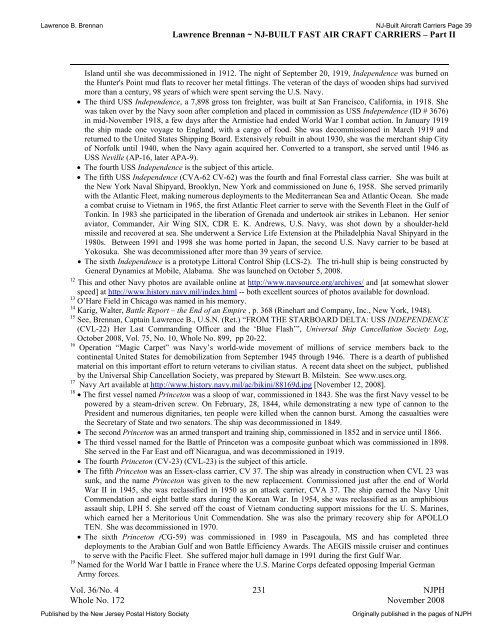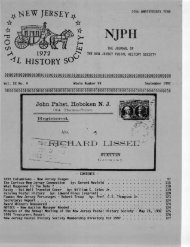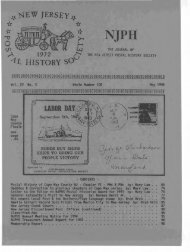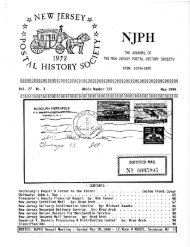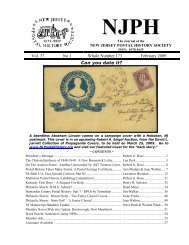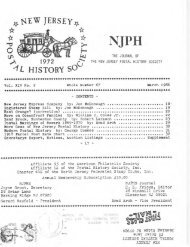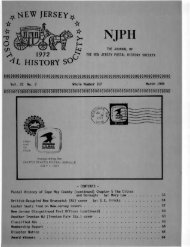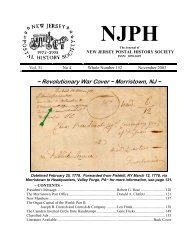By Captain Lawrence B. Brennan, U.S. Navy (Ret.) - New Jersey ...
By Captain Lawrence B. Brennan, U.S. Navy (Ret.) - New Jersey ...
By Captain Lawrence B. Brennan, U.S. Navy (Ret.) - New Jersey ...
You also want an ePaper? Increase the reach of your titles
YUMPU automatically turns print PDFs into web optimized ePapers that Google loves.
<strong>Lawrence</strong> B. <strong>Brennan</strong> NJ-Built Aircraft Carriers Page 39<br />
<strong>Lawrence</strong> <strong>Brennan</strong> ~ NJ-BUILT FAST AIR CRAFT CARRIERS – Part II<br />
Island until she was decommissioned in 1912. The night of September 20, 1919, Independence was burned on<br />
the Hunter's Point mud flats to recover her metal fittings. The veteran of the days of wooden ships had survived<br />
more than a century, 98 years of which were spent serving the U.S. <strong>Navy</strong>.<br />
• The third USS Independence, a 7,898 gross ton freighter, was built at San Francisco, California, in 1918. She<br />
was taken over by the <strong>Navy</strong> soon after completion and placed in commission as USS Independence (ID # 3676)<br />
in mid-November 1918, a few days after the Armistice had ended World War I combat action. In January 1919<br />
the ship made one voyage to England, with a cargo of food. She was decommissioned in March 1919 and<br />
returned to the United States Shipping Board. Extensively rebuilt in about 1930, she was the merchant ship City<br />
of Norfolk until 1940, when the <strong>Navy</strong> again acquired her. Converted to a transport, she served until 1946 as<br />
USS Neville (AP-16, later APA-9).<br />
• The fourth USS Independence is the subject of this article.<br />
• The fifth USS Independence (CVA-62 CV-62) was the fourth and final Forrestal class carrier. She was built at<br />
the <strong>New</strong> York Naval Shipyard, Brooklyn, <strong>New</strong> York and commissioned on June 6, 1958. She served primarily<br />
with the Atlantic Fleet, making numerous deployments to the Mediterranean Sea and Atlantic Ocean. She made<br />
a combat cruise to Vietnam in 1965, the first Atlantic Fleet carrier to serve with the Seventh Fleet in the Gulf of<br />
Tonkin. In 1983 she participated in the liberation of Grenada and undertook air strikes in Lebanon. Her senior<br />
aviator, Commander, Air Wing SIX, CDR E. K. Andrews, U.S. <strong>Navy</strong>, was shot down by a shoulder-held<br />
missile and recovered at sea. She underwent a Service Life Extension at the Philadelphia Naval Shipyard in the<br />
1980s. Between 1991 and 1998 she was home ported in Japan, the second U.S. <strong>Navy</strong> carrier to be based at<br />
Yokosuka. She was decommissioned after more than 39 years of service.<br />
• The sixth Independence is a prototype Littoral Control Ship (LCS-2). The tri-hull ship is being constructed by<br />
General Dynamics at Mobile, Alabama. She was launched on October 5, 2008.<br />
12 This and other <strong>Navy</strong> photos are available online at http://www.navsource.org/archives/ and [at somewhat slower<br />
speed] at http://www.history.navy.mil/index.html -- both excellent sources of photos available for download.<br />
13 O’Hare Field in Chicago was named in his memory.<br />
14 Karig, Walter, Battle Report – the End of an Empire , p. 368 (Rinehart and Company, Inc., <strong>New</strong> York, 1948).<br />
15 See, <strong>Brennan</strong>, <strong>Captain</strong> <strong>Lawrence</strong> B., U.S.N. (<strong>Ret</strong>.) “FROM THE STARBOARD DELTA: USS INDEPENDENCE<br />
(CVL-22) Her Last Commanding Officer and the ‘Blue Flash’”, Universal Ship Cancellation Society Log,<br />
October 2008, Vol. 75, No. 10, Whole No. 899, pp 20-22.<br />
16 Operation “Magic Carpet” was <strong>Navy</strong>’s world-wide movement of millions of service members back to the<br />
continental United States for demobilization from September 1945 through 1946. There is a dearth of published<br />
material on this important effort to return veterans to civilian status. A recent data sheet on the subject, published<br />
by the Universal Ship Cancellation Society, was prepared by Stewart B. Milstein. See www.uscs.org.<br />
17 <strong>Navy</strong> Art available at http://www.history.navy.mil/ac/bikini/88169d.jpg [November 12, 2008].<br />
18 • The first vessel named Princeton was a sloop of war, commissioned in 1843. She was the first <strong>Navy</strong> vessel to be<br />
powered by a steam-driven screw. On February, 28, 1844, while demonstrating a new type of cannon to the<br />
President and numerous dignitaries, ten people were killed when the cannon burst. Among the casualties were<br />
the Secretary of State and two senators. The ship was decommissioned in 1849.<br />
• The second Princeton was an armed transport and training ship, commissioned in 1852 and in service until 1866.<br />
• The third vessel named for the Battle of Princeton was a composite gunboat which was commissioned in 1898.<br />
She served in the Far East and off Nicaragua, and was decommissioned in 1919.<br />
• The fourth Princeton (CV-23) (CVL-23) is the subject of this article.<br />
• The fifth Princeton was an Essex-class carrier, CV 37. The ship was already in construction when CVL 23 was<br />
sunk, and the name Princeton was given to the new replacement. Commissioned just after the end of World<br />
War II in 1945, she was reclassified in 1950 as an attack carrier, CVA 37. The ship earned the <strong>Navy</strong> Unit<br />
Commendation and eight battle stars during the Korean War. In 1954, she was reclassified as an amphibious<br />
assault ship, LPH 5. She served off the coast of Vietnam conducting support missions for the U. S. Marines,<br />
which earned her a Meritorious Unit Commendation. She was also the primary recovery ship for APOLLO<br />
TEN. She was decommissioned in 1970.<br />
• The sixth Princeton (CG-59) was commissioned in 1989 in Pascagoula, MS and has completed three<br />
deployments to the Arabian Gulf and won Battle Efficiency Awards. The AEGIS missile cruiser and continues<br />
to serve with the Pacific Fleet. She suffered major hull damage in 1991 during the first Gulf War.<br />
19 Named for the World War I battle in France where the U.S. Marine Corps defeated opposing Imperial German<br />
Army forces.<br />
Vol. 36/No. 4<br />
231<br />
NJPH<br />
Whole No. 172 November 2008<br />
Published by the <strong>New</strong> <strong>Jersey</strong> Postal History Society<br />
Originally published in the pages of NJPH


